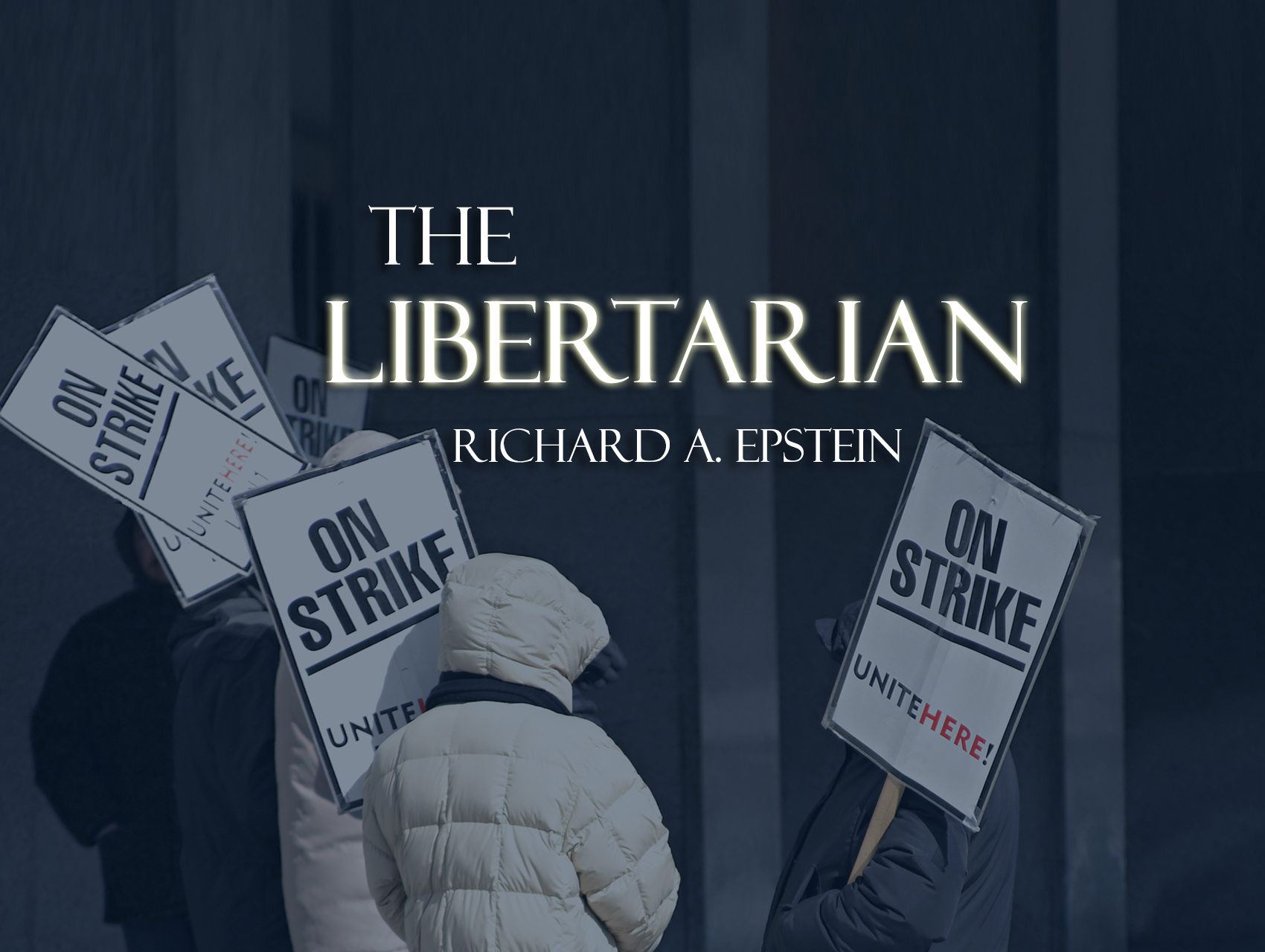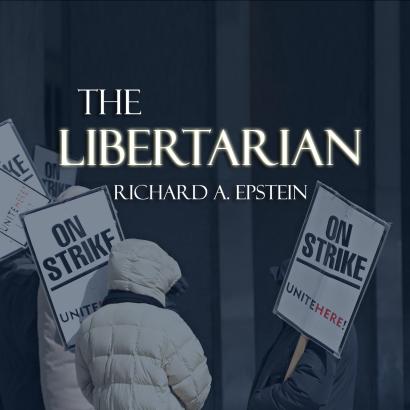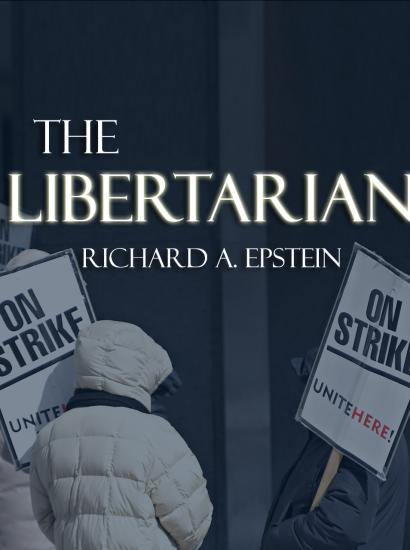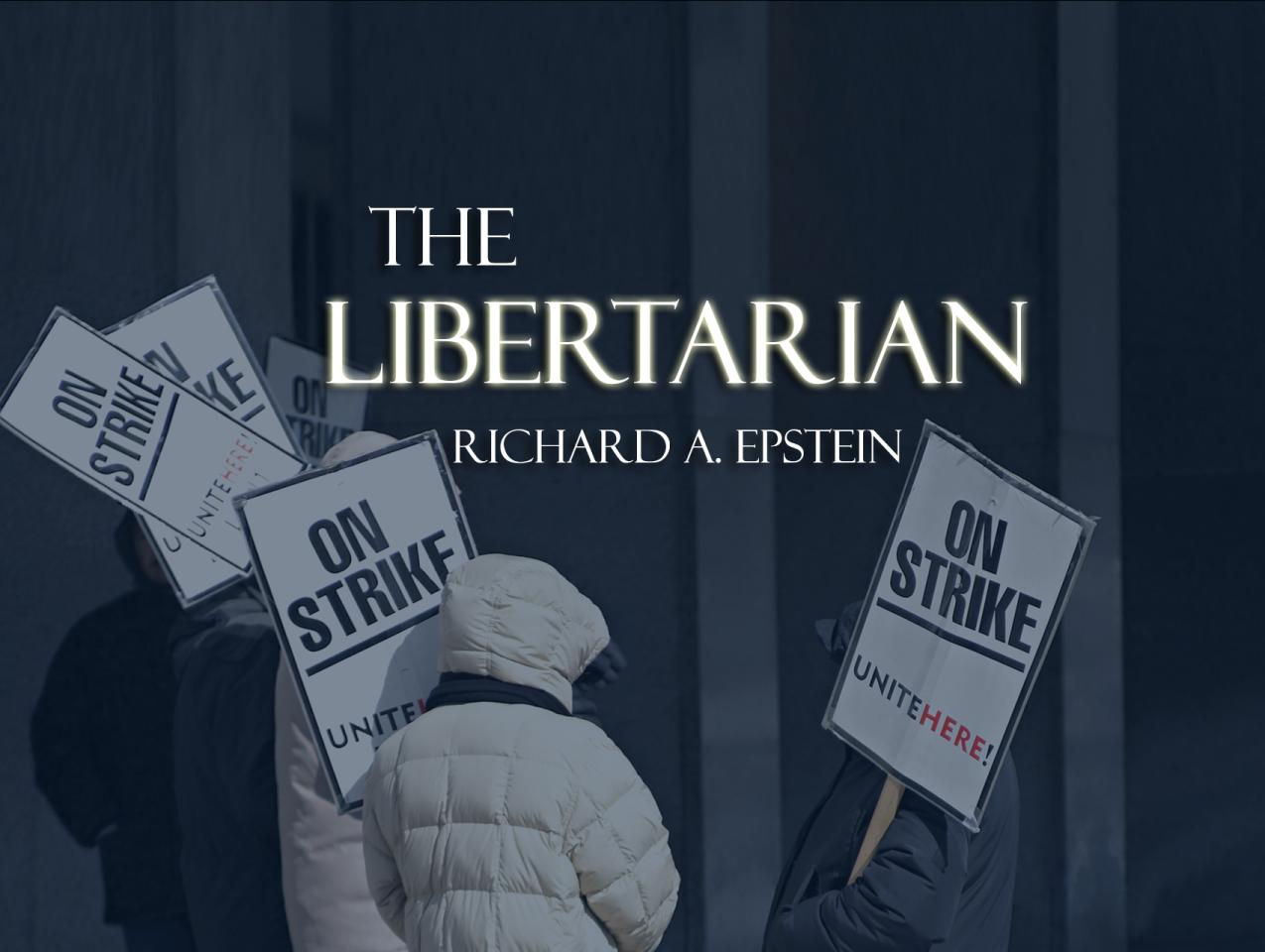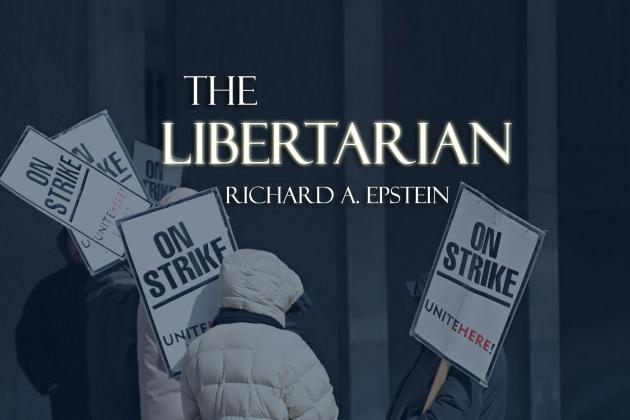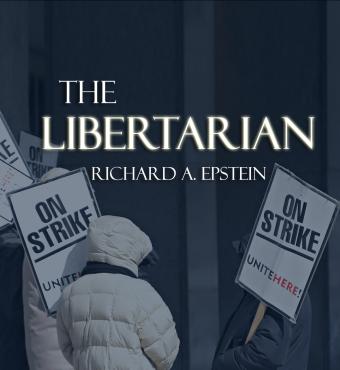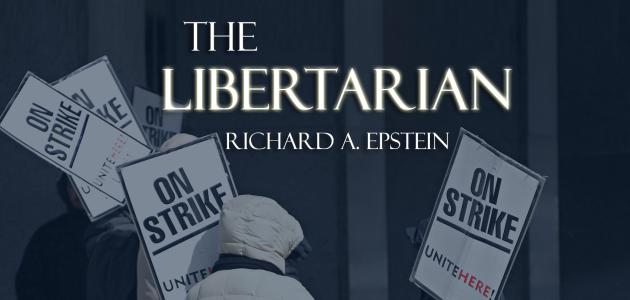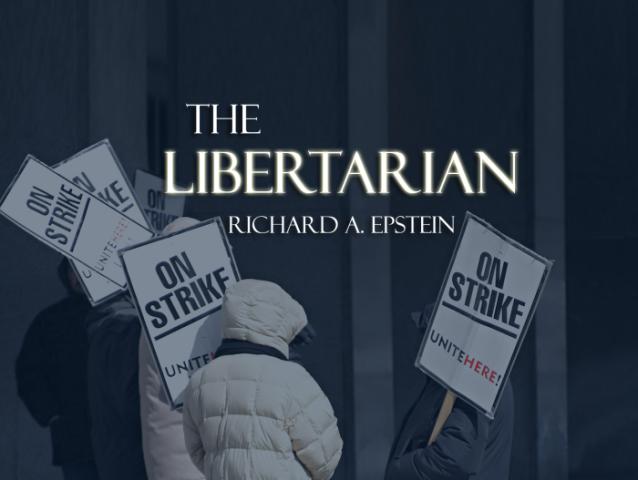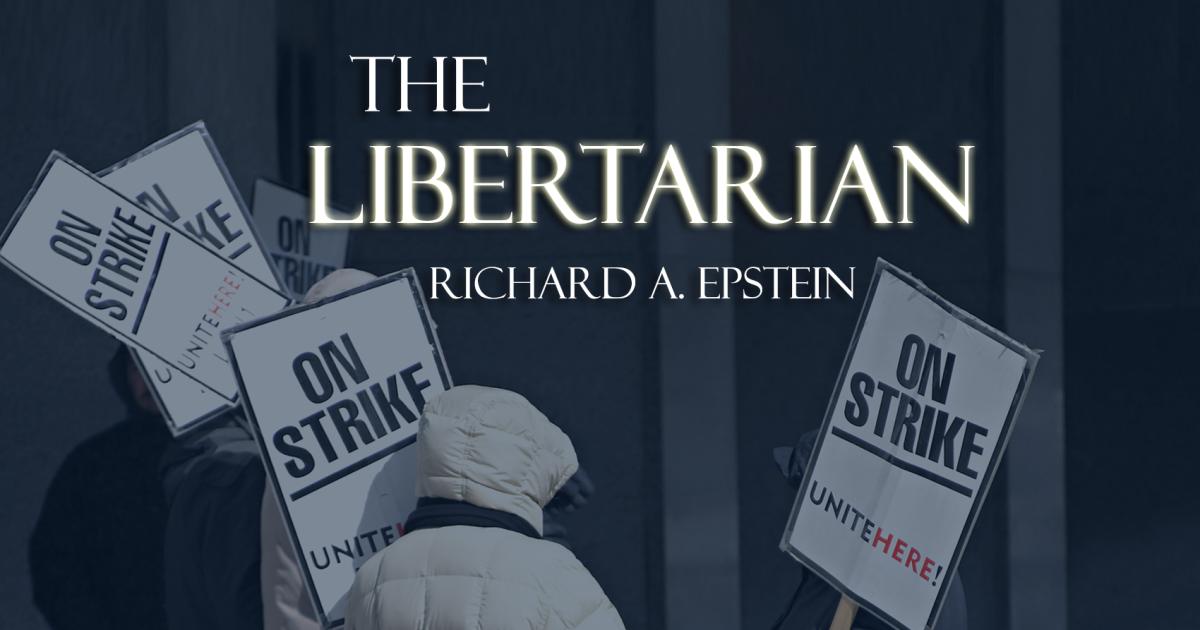Richard Epstein discusses a new case at the Supreme Court that involves tricky questions of purposeful harm from unions when going on strike for a better contract.
>> Tom Church: This is the Libertarian podcast from the Hoover Institution. I'm your host, Tom Church, and I'm joined, as always, by the libertarian himself, Professor Richard Epstein. Richard is the Peter and Kiersten Bedford senior fellow here at the Hoover Institution. He's the Lawrence Atish professor of law at NYU and is a senior lecturer at the University of Chicago.
And, Richard, this week I'd like to discuss what I think is a fascinating legal fight involving unions and the methods in which they protest. The case I wanna talk about just was argued in front of the Supreme Court, it's Glacier Northwest versus the international Brotherhood of Teamsters. Now, the context, I suppose, I wanna lay down is that the Teamsters drive cement trucks for Glacier Northwest.
And when upcoming negotiations failed and right before the contract was about to expire, the union drivers took off with loaded cement trucks and then return them when the contract expired with wet cement still in them. Now, obviously, the company was unable to offload all the cement in times causing it to harden and ruining several or many vehicles.
And the key questions, I think, in this case are, well, there's a lower level one were their actions, a protected strike practice under the National Labor Relations Act? And then the bigger one here is which court has jurisdiction to resolve this case? Now, Richard, I have a feeling you're gonna give me a history lesson in order to begin to understand how to parse through this.
But how is this at the Supreme Court, but it could be argued somewhere else?
>> Richard Epstein: Well, the reason it got to the Supreme Court was through an unconventional route. The case was brought, actually by the employer, the glacier company. It was brought against the union in Washington state court and the tort that was alleged was the intentional destruction of physical property to with the trucks and the cement.
What happened is, under the traditional rule, the union could defend and say, no, you're not allowed to bring this here. Because this is material which is, in fact, effectively covered under the National Labor Relations Act, and that will preclude the tort action. Well, to decide that, you then have to figure out just how far is the reach of that statute.
And there's a famous case called Garmin against another one of these unions. And what happened in that case, a very different California Supreme Court in the 1980s was faced with a union organizing drive. And what happened is the employer brought an action in the state court for basically a conspiracy and restraint of trade.
The first time this thing comes up, the Supreme Court makes it pretty clear that you can't get an injunction to deal with this through the state court, because that's the business of the National Labor Relations Board. So it trundles back down again, and the state of California decides this time it's only gonna impose a damage fine on the union in this situation for $1,000 goes right up to the Supreme Court again.
And what happens is Justice Frankfurter makes two claims. One is he says that it turns out that if you're talking about this situation, a damage action is coercion, because even though you can escape the penalty, stopping the activity by paying the penalty, it's just too much of a physical inducement, a legal inducement to do it.
So the fact that you're not getting the injunction, the specific order, is not enough. And then he says, well, what the jurisdiction is, is whether or not this is arguably subject to the jurisdiction of the National Labor Relations Board. Doesn't have to be certain, it's just that it's kind of more likely than not is a kind of a rough standard.
And in this particular case, he said, look, what they were being a challenge for was coordinated activities which was intended to make it more difficult for the employer to operate its business. And he says, that's exactly the kind of coordinated activity which is governed by a union law.
So even if the National Labor Relations Board doesn't move, you guys are gonna be out of luck and the case is going to be dismissed. So when it gets down to the Washington state court, there is the same question as to whether or not this thing is preempted under the arguably subject standard.
And the argument that they make is anything that is incident to a labor dispute is something that necessarily belongs inside the union context and is not something you could bring in state court. The Garmin case, which I just referred to, had the following statement about certain activities that are against local feeling and responsibility.
And what it seemed to say was that if you commit tortious activities, physical destruction, there's nothing about the structure of the National Labor Relations Act which says that state courts cannot protect people against willful property damage. And in this particular case, the argument went on the other side, that's exactly what happened.
But the Supreme Court in Washington state rejected that argument, and the case comes to the Supreme Court and this is very funny situation about what counts as physical damage. Because it's clear that what happened is the union only set into motion the set of circumstances that would result in destruction of property, but the employer had the trucks back and could do something to mitigate the damage.
It's not as though when they drove the trucks back what they did is they bashed them into multiple pieces. And so the question is whether or not this slow death by physical injury counts or not. And that's what the Supreme Court is going to have to discuss. And it brought forth some very different reactions on the part of the Supreme Court, roughly speaking, the liberal three
>> Tom Church: Richard, would you expect that the court's ruling on tort damage to be different than the NLRB?
>> Richard Epstein: Well, the NLRB doesn't have an ability to organize tort damages. This was a very complicated statutory scheme, and for the most part, the remedies that it gave were relatively limited. You could basically have an unfair labor practice and order people to engage in collective bargaining. It's very rare that you will actually tell them, this is what you have to do.
And it turns out that damages are not something that you could award against an employee. And until very recently, when the NLRB changes conditional provision, the only thing that you could award workers who were wrongfully dismissed was back wages. You could not organize consequential damages for the dislocations in their home mortgage and in their personal life.
That came when they cut out of a salary. So the reason why most people think that the decision is forward, at least most people I agree with, is that if you keep it in the National Labor Relations board, there's no compensation whatsoever. And the remedial structures that they have don't mean anything particular.
It's worth noting that they did this and one week later they had actually worked a settlement. And if this were a national labor relations unfair practice situation, the settlement would essentially negate the jurisdiction of the National Labor Relations Board. But if it's a tort action, it would survive in state court.
So these procedural differences matter hugely. If you had to go first to the labor board before you could bring a tort action, they can sit on this thing for five years. By which time your evidence is stale, which is why the situation has always been organized in the other direction.
Allege something serious like the wolf of destruction of property, and you're in state court, and now the union has to fight to keep you out. And in previous cases, the decision of the Washington Supreme Court, I think, would not have been followed. And so when the case comes up to the Supreme Court, I think the best way to understand it is that the conservative judges thought that this was a deviation from the traditional activity.
They are suspicious about unilateral changes in either state or federal court which advances union causes or indeed, advances in an unprincipled fashion management courses. So the betting was at the time that this thing came up, there was that it was set for corrective reaction. And having reviewed the oral argument in the case, I'm pretty convinced that that explanation holds water.
I think more likely than not that decision I think
>> Tom Church: Richard, one of the things that I've started to appreciate more about the law and the UN ruling is that it's not just about the facts in the case there, but the effects it's gonna have on the future.
And so I'm worried about how this ruling could work, could come down, and then what strikes might look like in the future. Should I be worried about that? Are other union groups gonna look at this and say, hang on, this group did this, it's pretty clever. They're not getting punished and a tort side, or it's being pushed off on an LLB ruling for years and years.
This is an effective way to get what we want.
>> Richard Epstein: For the most part, you haven't had too many cases which involved this sort of violence. The Garmin case was an easy case because the collective refusal to deal is what unions are supposed to do. And it's widely understood that a strike will disrupt the ability of the employer to discharge his contracts with other people.
But those risks are regarded as incidental and therefore not a reason to strike down the particular action. If you were a common law judge, like I am, you would say, aha, this is an interference with contractual arrangements. And the losses to third party that were intended and foreseeable and actual, all three of the above, are things for which the union have to pay damages.
But what's going on in this particular case is unions under the National Labor Relations act have a very, very privileged status. The issue is, how far does the privilege extend? So, for example, what a union can do is to say, you're not allowed to deal with any employees unless you deal with them through us.
And this was a case called J.I case back in 1943. There had been an existing contract with some of the workers. The union comes in, negotiates another deal, and Justice Jackson for the Supreme Court said, the statute is so powerful. That what happens is that the preexisting contracts between the employer and the employee, though otherwise valid, are now completely voided because the union situation starts to dominate.
And then, of course, it turns out the union can't deal with any individual privately, and it has to deal with the union in good faith. A very mysterious phrase but it does mean, at the very least, you can't say, I don't want to talk to you people, you have to talk to them.
And then the question is, what kind of offers do you have to make, if any, what kinds of conduct and negotiations you have to do? It's a huge problem, but this is another straight union preference. None of this stuff is, in effect, going to be challenged by the decision that you would get in the glacier case.
What challenges the issue is to whether or not you could add force of a direct sort to the usual tactics that the union have. And the argument on the part of the employer is, no, you're not allowed to do two things. There's one thing you could do, and it's bad enough.
Please don't try to extend it any further. And then the sub question is, if you just simply send the things into the plan, but they're not going to explode, does this count as the use of physical force? There are a number of cases having to do with this issue, and it gets complicated again.
One of the doctrines that's commonly said to apply is that if a union is out on strike, but it understands that there's some imminent peril to the employer's property. It's gonna be under a duty to take reasonable steps to foreclose or to prevent the damage in question. Well, does that doctrine apply here?
And the answer is not really. This is not a question of knowing that something is about to happen to these trucks when they're inside the place. This is a question of having set the bomb yourself. And so therefore, it's not a question of foreseeable prevention, it's a narrower doctrine which says that you cannot set traps to take place.
So they give a more vivid version of this. Suppose what they had done is outside the plant, had planted a bomb in this thing, and it set it to go off an hour after it was returned to the area. Could they say, since it turned out that the bomb was not set while they were in the plan, it's not going to count as a cause of the damage that took place there?
I think the answer is no. And there are taught doctrines to the effect of, if I start to, to create, even innocently, a dangerous condition which is likely to cause damage to a third party, and I'm in a position to remove that peril, I'm under a duty to do so.
And so cases like that are designed to deal with what some people call complex acts, that are situations where you first create a situation, endorse for a while, and then you have options in order to shut it down. And the theory of the complex act is that you're under duty to shut this thing down.
But in this case, it's even worse, because the whole thing was part of a unified, conscious scheme. So I think, in effect, the argument that this is not physical damages, that's outside the scope of the National Labor Relations act, is likely to fail, and that they're going to send this thing back to the state court.
You still have the further problem. State courts have a lot of discretion on how they apply their tort law. And it doesn't say that because the union jurisdiction has been removed, that the state will cooperate when it comes to dealing with the level of tort damages that it's going to award.
All of these problems are par for the course under any system of federalism, particularly when the federal is
>> Tom Church: Because I do wanna ask about the report the Supreme Court released today regarding the Dobbs case and the leak back in last May. I'm not sure how much you've looked into it, but the top line details, they investigated 100 employees, some more than 80 had access, couldn't find a preponderance of evidence to point to any individual.
A lot of the reaction I've seen is that they didn't talk to the justices themselves. And, yeah, I guess maybe we just didn't put the blame on any one person. You have a longer institutional memory of the Supreme Court than I do have. Remind me one, have other leaks like this happened before?
Would you expect them to happen more in the future, considering no one's being punished? And are you satisfied with the results of this investigation?
>> Richard Epstein: Well, I'm not happy with the results of the investigation. Let me give the obvious explanation as to why, if you look at it, it said there was no preponderance of evidence of who did it.
That's consistent with the statement that there's somebody whom they think to be 25 or 30% likely to have committed the offense, whereas of the other 80 or so people, virtually all of them have zero probability of being involved. And so the question is, what ought you to do if it turns out you have substantial evidence, but not profound, a preponderance of evidence which point to one individual or a small group of people?
To treat this as though you haven't learned anything is to understate the amount that you've done. And so, for example, normally, if you had substantial proof that somebody had engaged in stuff, short of a preponderance of evidence, and sort of beyond a reasonable doubt. You could refer it over to a prosecutor to take over the case.
And nobody seemed to want to do that under these circumstances. There's something about this, because we know they know something from this evasive wording. We have no idea of how much it is. And there was certainly not the slightest inclination to reveal to us the names of the people who were the prime two or three subjects.
And it seems as though they did not incent this stuff over to anybody in an enforcement agency to follow it up. So, there's gonna be a lot of uneasiness. The question is, what's gonna happen next? It works both ways. There's a very powerful argument to say that this case is one of a kind, which is why it never happened before.
It turns out that everybody knew that Alito was right in the opinion. People thought that there was going to be a strong likelihood that it would overturn. If you leak the opinion, the argument was, he could no longer change his mind. So that's a reason why some Republican might want to get it out.
But on the other hand, if you release the opinion early, it gives a chance for the opposition to the result in that particular case to form. And so that there's gonna be a real political push against it, which somewhat happened in the course of the 2022 election. So you have explanations on both sides as to how it is.
There's also a third complication here, it doesn't have to be only one person. You can have somebody who simply finds the file, basically, takes it out quickly, somebody else photoshops or copies all the pages, and they put it back, and it's a conspiracy of two or more people.
But you can't find anything in the documents that will show it, because everything is exactly what it was before the thing was taken. Well, the next time anybody knows that they could get away with this stuff, and so they'll do it again. But it turns out the next time you may be caught and the gains the next time may not be nearly as large as they are in this particular case.
Some people often ask me about trade secret cases, and the most common use of a trade secret is to keep it as a trade secret. That is, if you steal somebody else's processes, you don't wanna tell the rest of the world what you're doing, because that way you lose the industrial advantages that you get.
But the situation is very difficult when you're talking about political releases, where you wanna get the broadest amount of information out there. And so publicity is the same thing, cuz you're not trying to influence the way industrial products are going to be produced, you're trying to create discredit and suspicion on one or another group of parties.
So I'm not sure whether this will ever happen again. I would certainly hope that it does not. The one thing that we don't know is whether or not from this report, they have decided on a set of institutional safeguards that they could put into the case, which would raise the probability of detection and therefore reduce the incidence of events.
We don't hear anything about that. So there's a lot of things that are unstated about this report. But when it comes to the competence in the Supreme Court, I think most of them are much more like the situation we have in the Glacier case. What it is, is you get a very important issue, and the Supreme Court tries to resolve this thing, and those forms of improprieties are not there.
The real influences in these cases are the political atmospherics, on the one hand. And then there's this huge amicus curiae culture in which hundreds of people, quite literally in some cases, write briefs about these things in an effort to skew the outcome. And then there is, of course, the inevitable political discussion of this.
But I think that those methods which are not always perfect in the way in which they go are very much going to be alive today. The Supreme Court is simply too important an institution for its decisions to be resolved, particularly when matters are new by four or five people.
It was a five to one vote in the Epstein, not in the Epstein household. I'm not even sure with the five to one vote. But it turns out that in all of these cases, what you do is, you get very heavy votes one way or another. And these are not the kind of situations for which it's very likely you're gonna hear some kind of a leak.
I think the most important issue in the Supreme Court at this particular point are the ideological divisions. How long will they persist? Are they gonna be cases of compromise? Is there gonna be another appointment coming down the road? I would say, the backward situation is very, very unhappy.
But the forward questions that we worried about the Supreme Court will not dwell on this case cuz we don't have a victim and we don't have a scandal, which means that it will never disappear from public view, but it won't occupy central stage.
>> Tom Church: You've been listening to the Libertarian podcast with Richard Epstein.
Make sure to read Richard's weekly column, the Libertarian, published on Defining Ideas at hoover.org. If you found our conversation thought provoking, please share it with your friends and rate the show on Apple Podcasts or wherever you're tuning in. For Richard Epstein, I'm Tom Church, we'll talk to you next time.
>> Speaker 3: This podcast is a production of the Hoover Institution, where we advance ideas that define a free society and improve the human condition. For more information about our work, or to listen to more of our podcast or watch our videos, please visit hoover.org.







